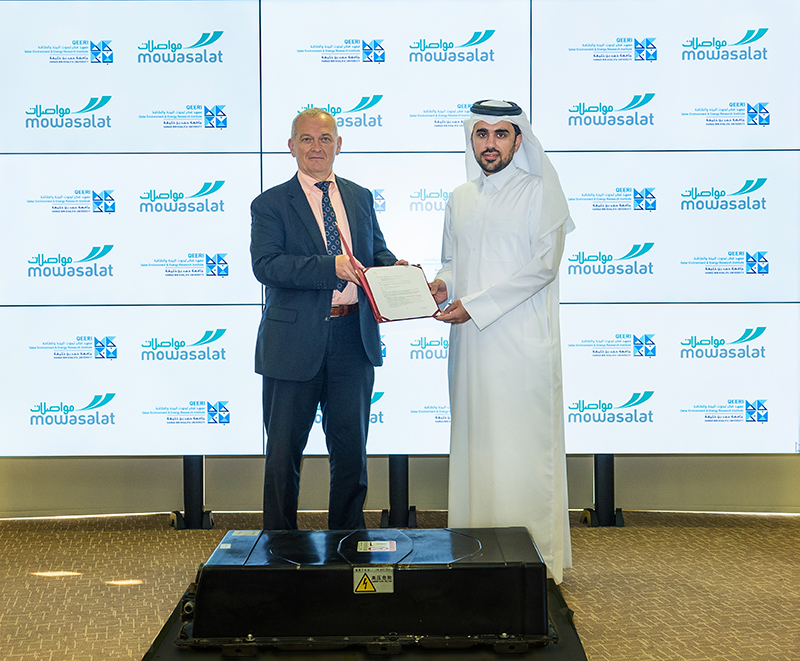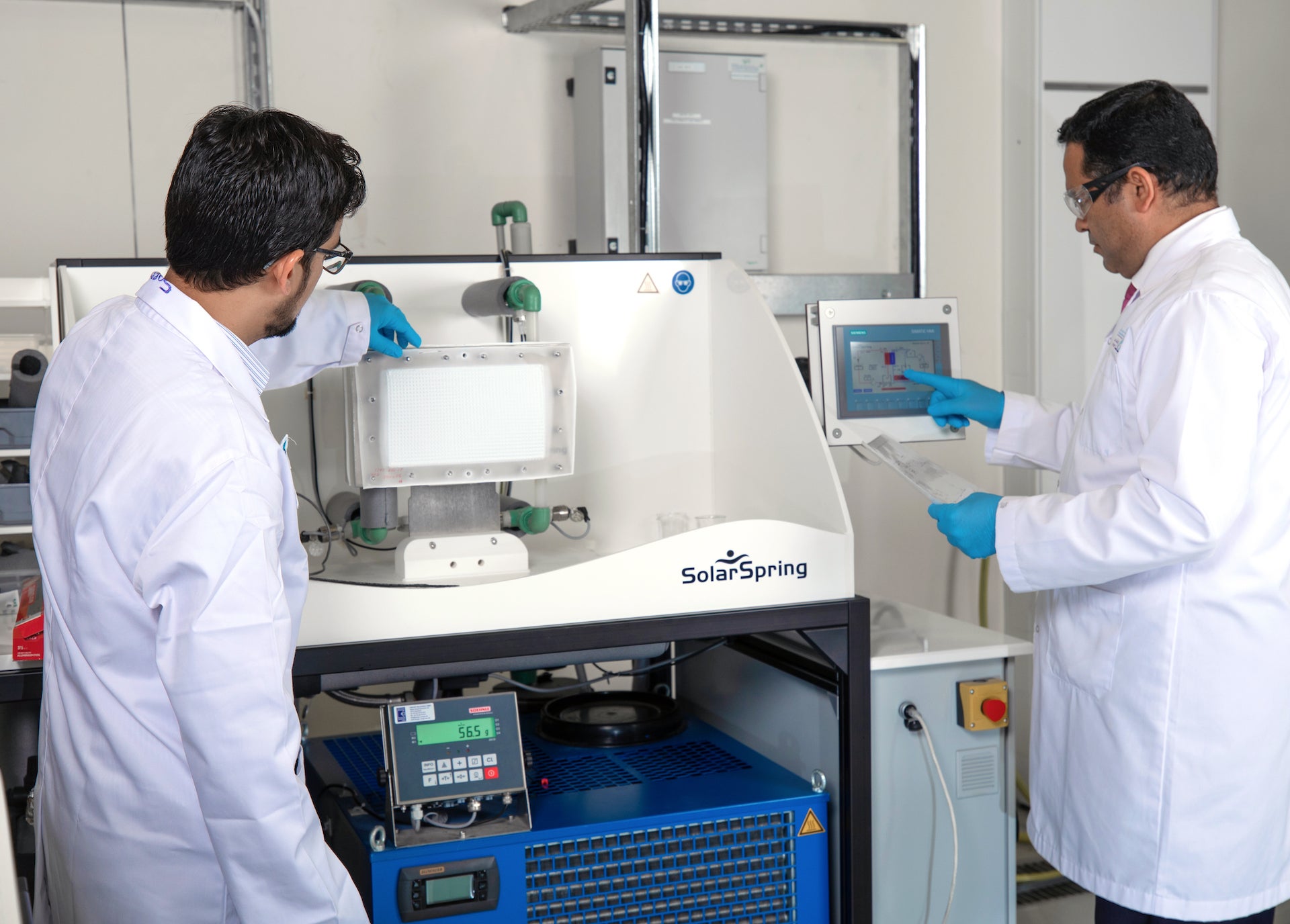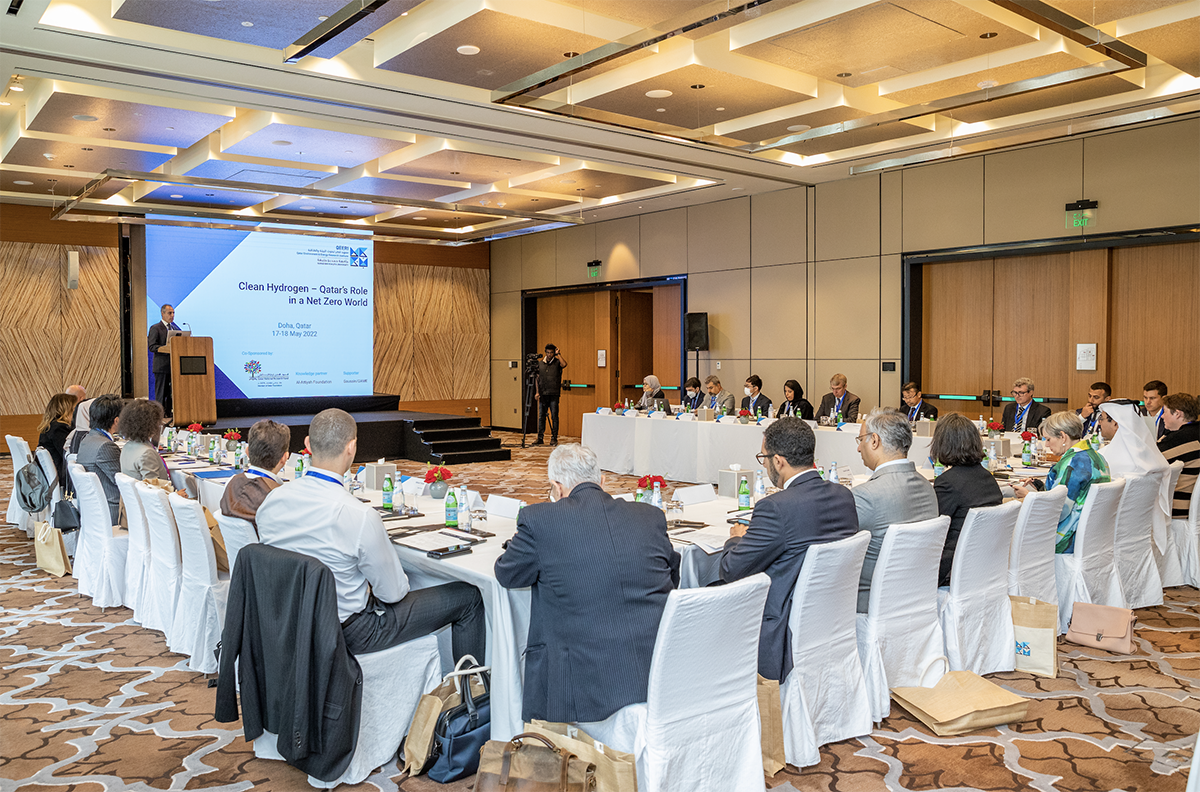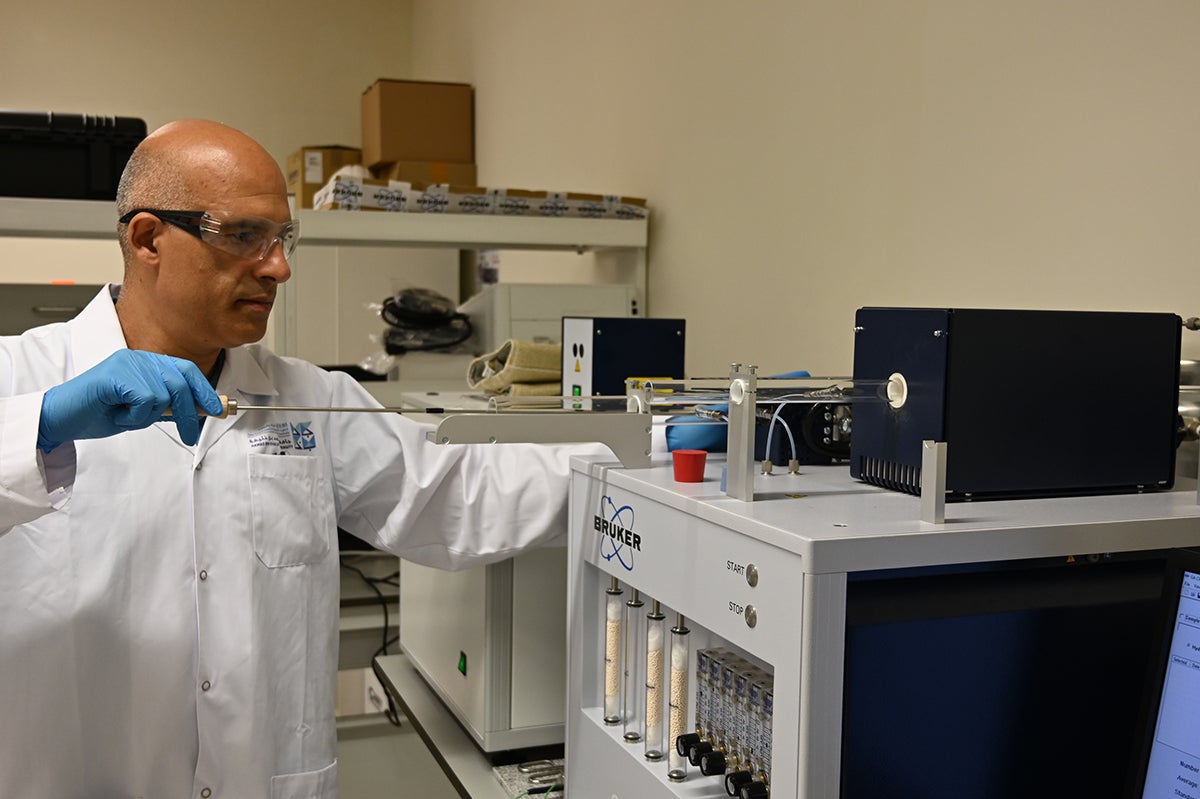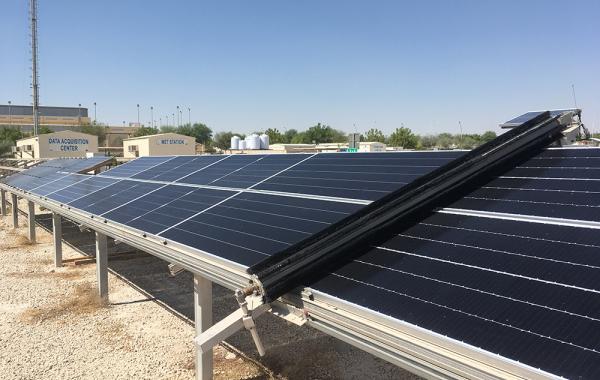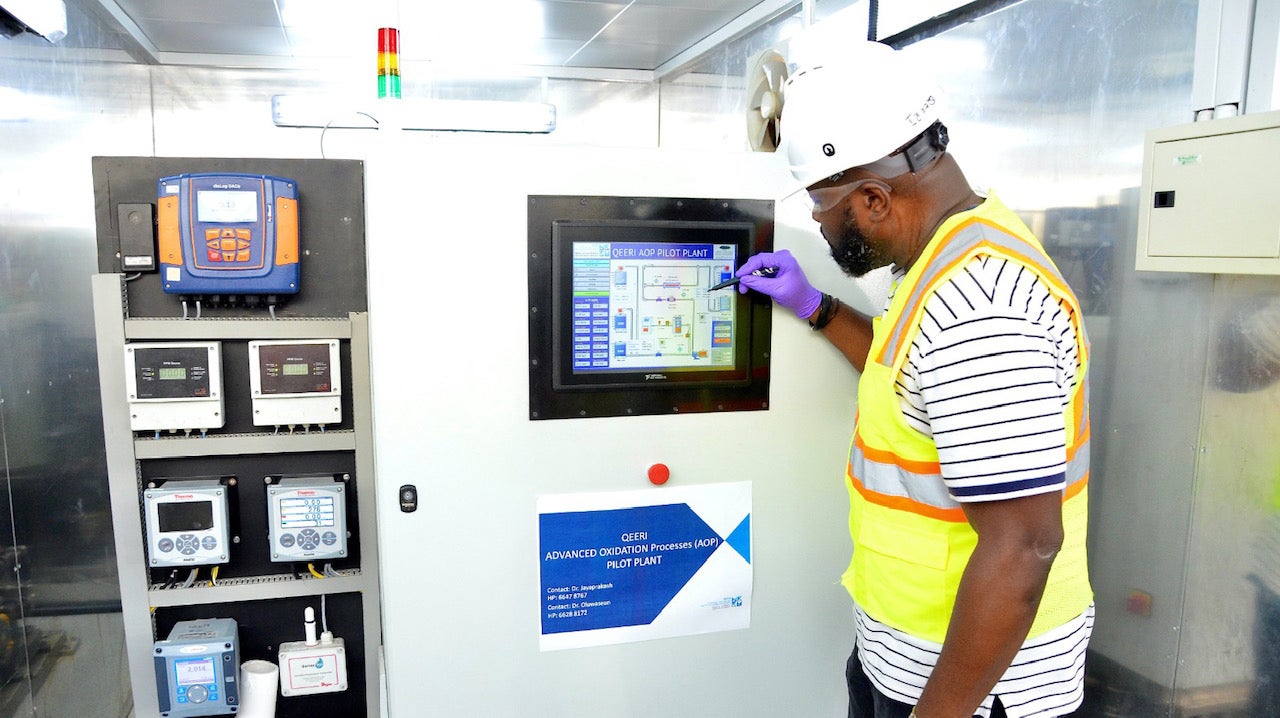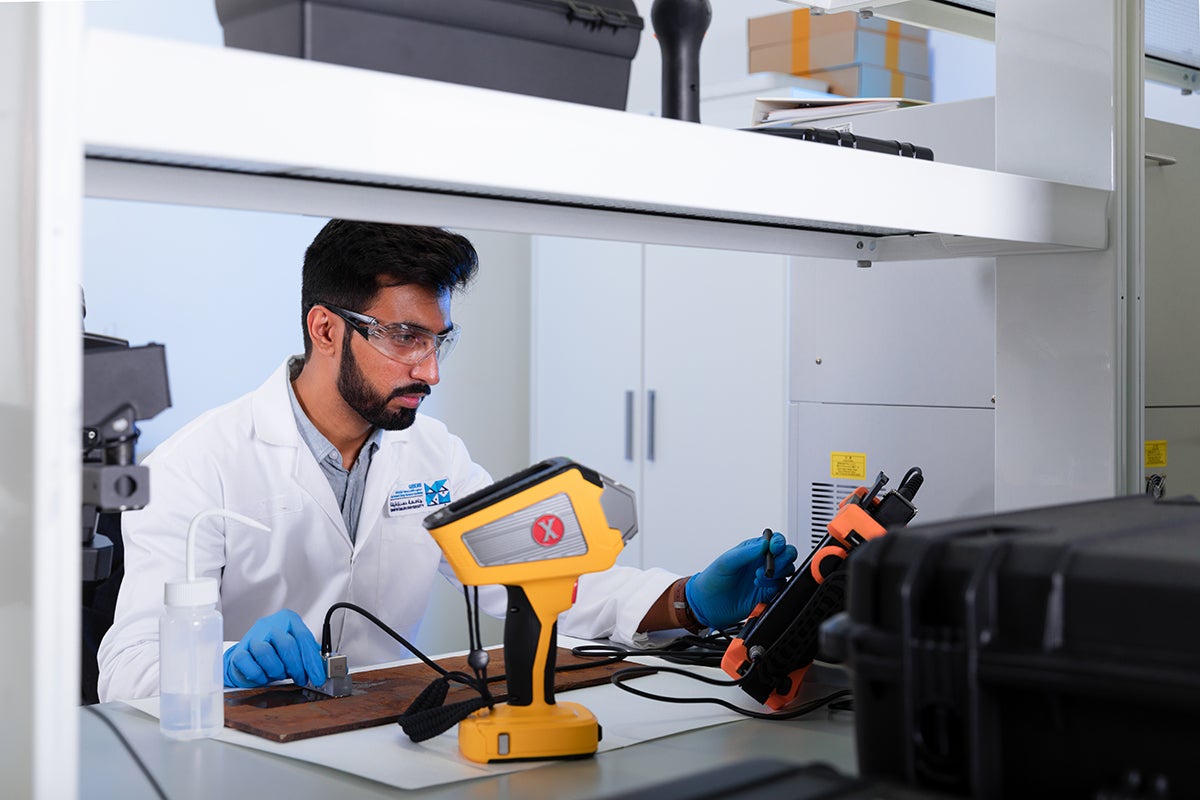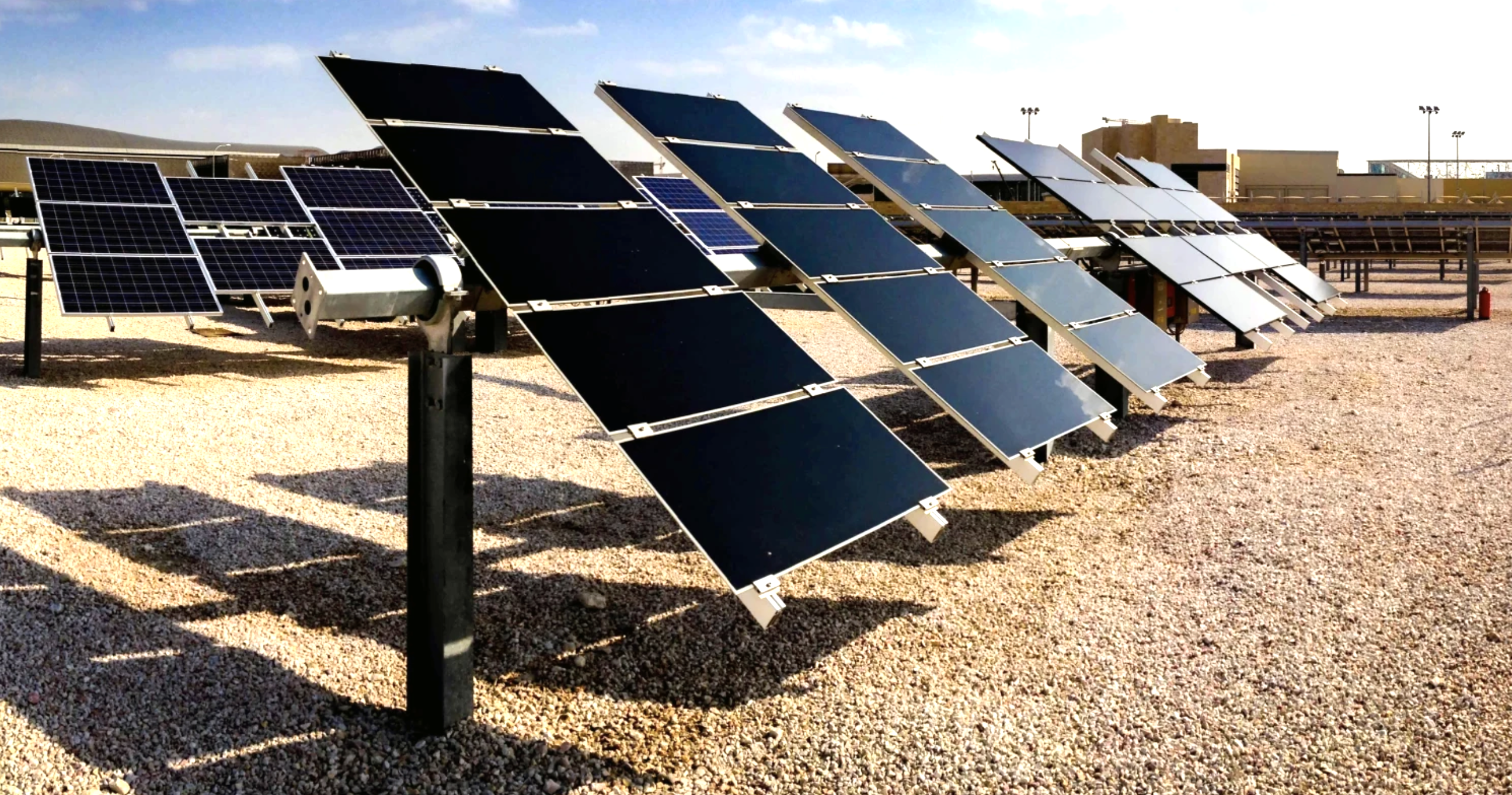
QEERI Aspires to Maximize Photovoltaic Energy Yield
QEERI Solar Consortium advances goal of developing solar technologies for desert conditions

Qatar Environment and Energy Research Institute (QEERI), part of Hamad Bin Khalifa University (HBKU), has begun operating a new horizontal single-axis photovoltaic (PV) tracker (HSAT) system capable of providing real-world data to maximizing solar energy generation in order to provide real-world data related to hot desert climates.
The project is an initiative of the QEERI Solar Consortium, a collaborative research group involving QEERI, KAHRAMAA, and solar companies from across the globe.
Using horizontal single-axis tracking (HSAT) technology, the 134-kW system is located at QEERI’s state-of-the-art Outdoor Test Facility (OTF) in Education City, close to its PV Reliability Lab, where the modules will be measured and tested in detail.
The HSAT system was provided by consortium member Soltec, a Spain-based industry leader in large-scale solar tracking projects. Hanwha Q Cells, Maxeon Solar, TotalEnergies, and QEERI provided the PV modules for testing.
Dr. Veronica Bermudez, Senior Research Director at QEERI, said: “This is one of the world’s most significant HSAT research projects and we intend to capitalize on its capabilities to produce unique, valuable data to enhance Qatar’s solar energy capabilities. The deployment of the system is a milestone that also enables QEERI’s Energy Center to further its research on optimizing solar technologies for the challenges of desert conditions. We thank the members of the Solar Consortium for their support and sustained efforts that help to accelerate the renewable energy transition in Qatar and the region.”
The new system is designed with seven rows of trackers and 15 different kinds of PV modules. A unique feature is the different spacings between the tracker rows, which will help determine the optimal HSAT layout for local conditions. Additionally, the use of different PV modules will help determine which technologies perform best in Qatar’s heat, dust, and ground reflectivity. As part of that, the effects of different positions and quantities of modules on the trackers will be studied.
Dr. Marc Vermeersch, Executive Director of QEERI, commented: “With a total investment of approximately $450,000, the consortium’s operational strategy aims to demonstrate, validate, and accelerate the development of solar energy technologies that are suited to desert conditions, in order to increase the PV energy yield for Qatar and the region.”
Previous research by QEERI has shown that single-axis trackers in Qatar increase the annual energy production of one-sided PV modules by at least eight percent. The new project will focus on the energy increase from using two-sided (bifacial) PV modules – which produce solar power from both the front (direct sunlight) and back (albedo) of the panel.
With the installation and operation of the system now underway, QEERI has begun planning for stage 2. This phase will include data analysis, and enhancements to the HSAT PV tracker system.
Related News
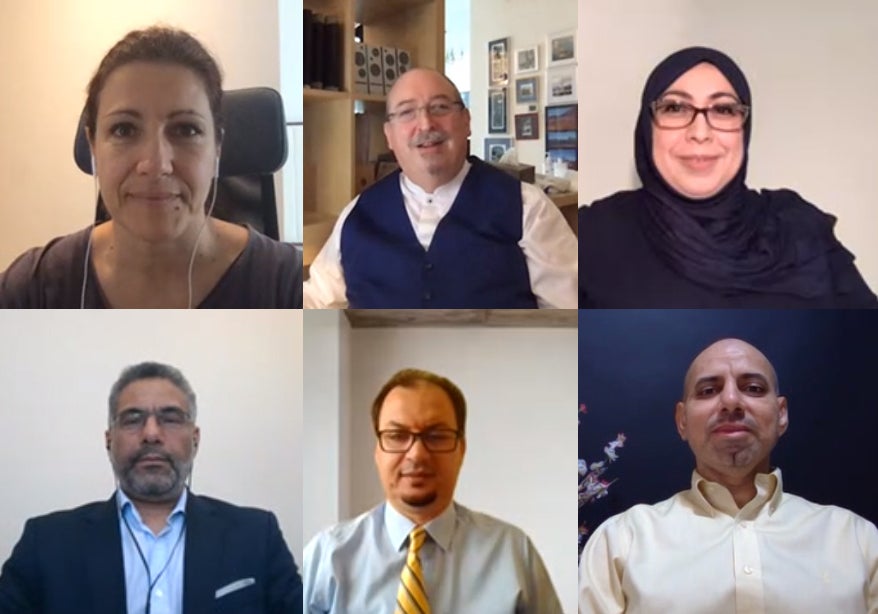
QEERI at HBKU to Lead New Project Focused on Reducing Atmospheric Carbon Dioxide
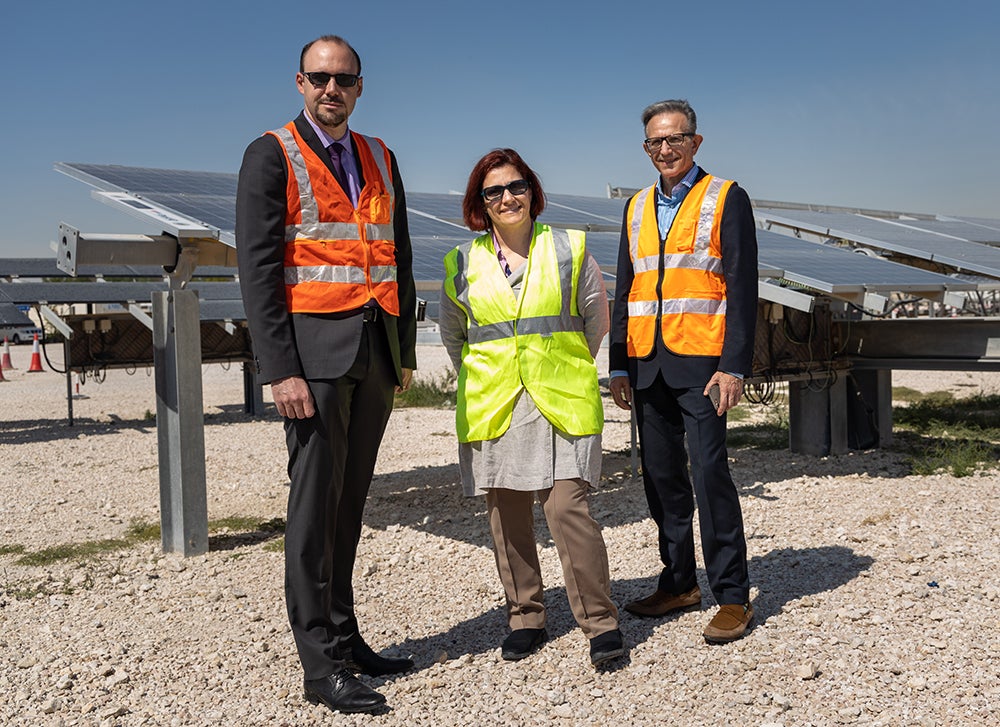
Qatar Environment and Energy Research Institute Providing Key Data for Development of Al Kharsaah 800MWp Photovoltaic Plant
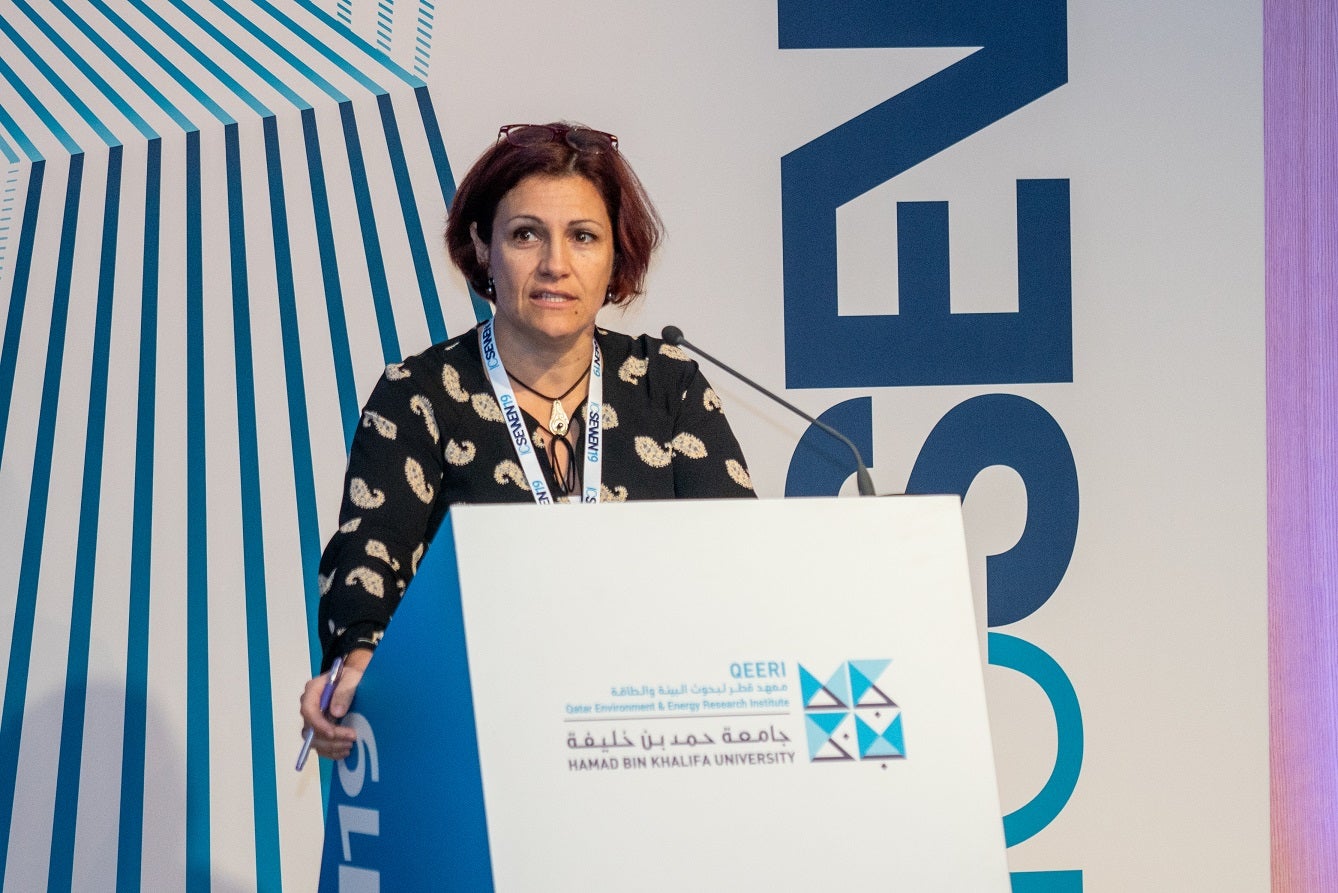
Experts Combine Efforts to Address Climate Challenges at Qatar Environment and Energy Research Institute Conference
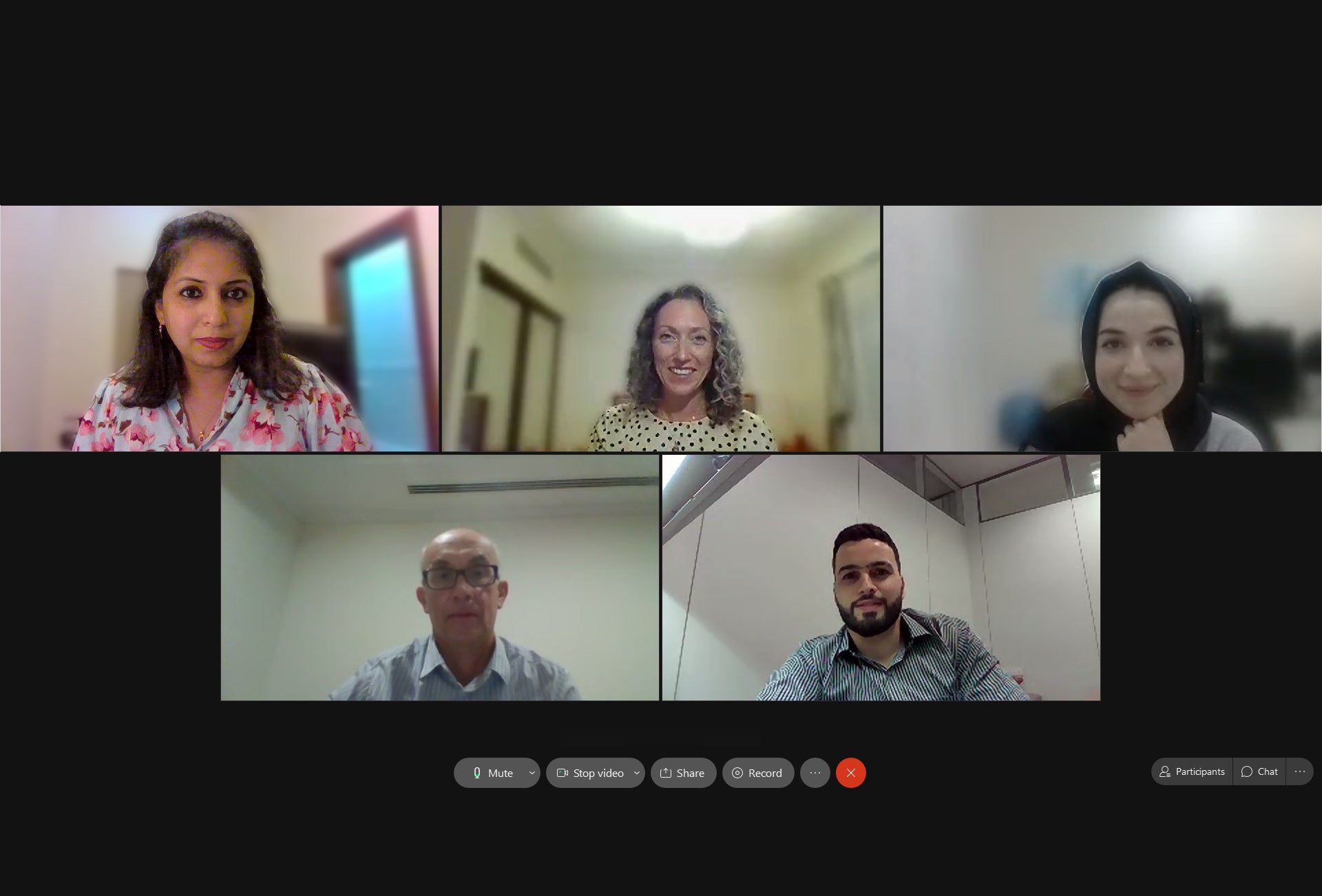
Qatar Environment and Energy Research Institute’s Second Science Majlis Promotes Awareness of Managing Scarce Water Resources
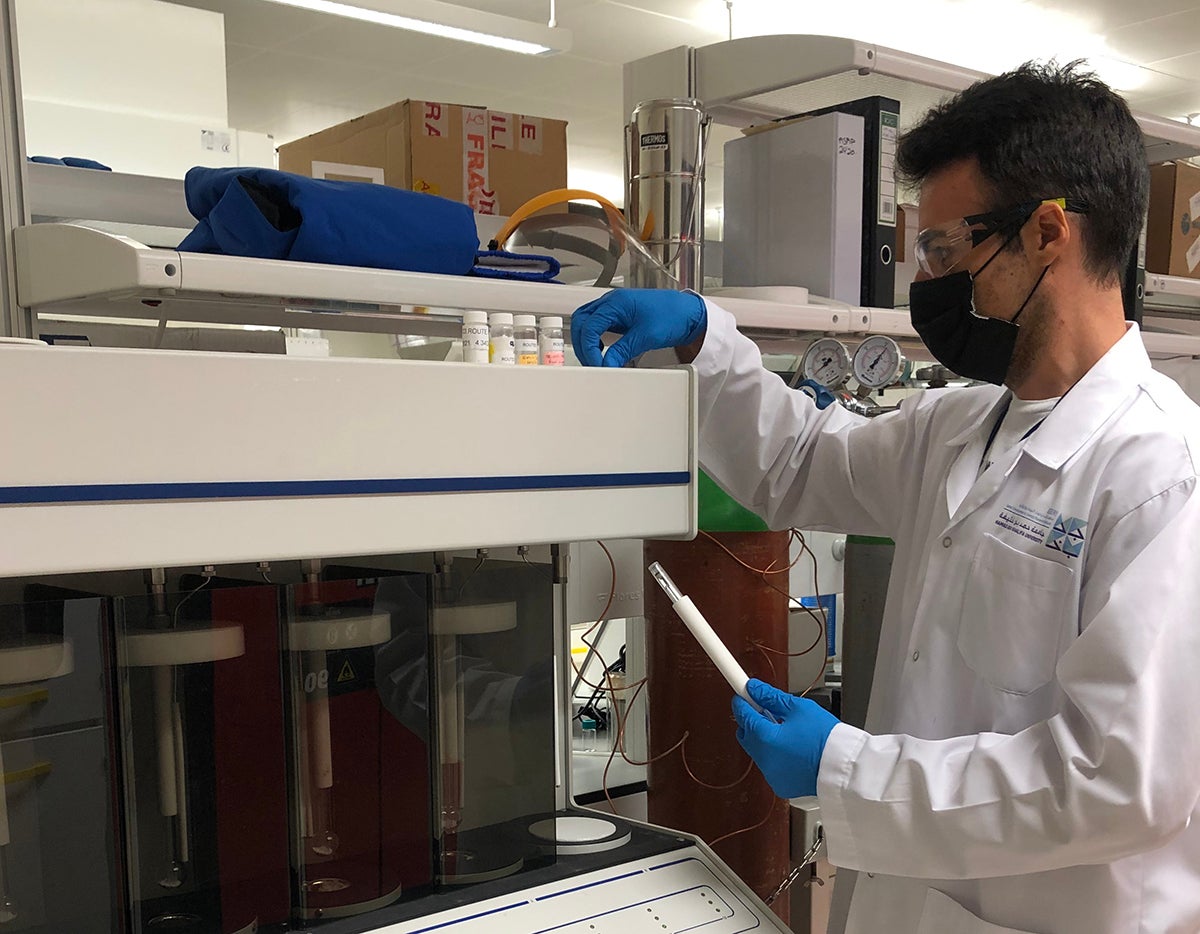
Research and Development Efforts by Qatar Environment and Energy Research Institute Focus on Innovation in Carbon Capture, Utilization, and Storage Technologies
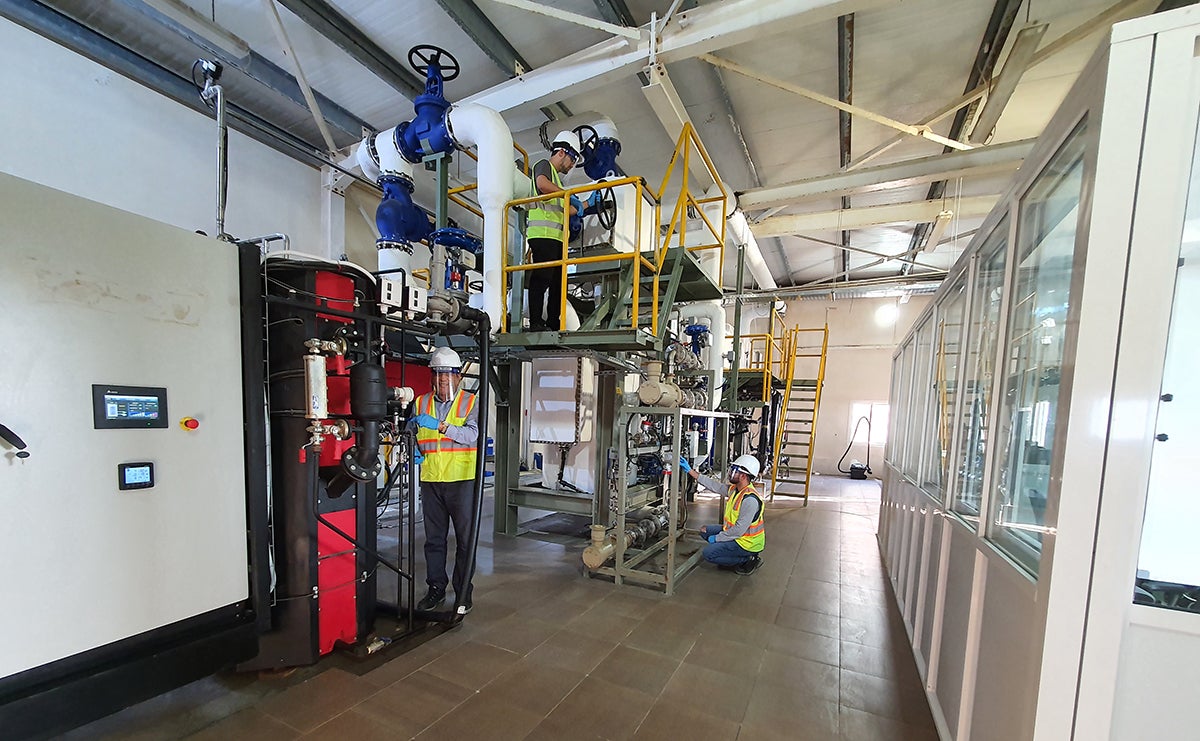
Qatar Environment and Energy Research Institute Develops and Installs MED Seawater Desalination Pilot Plant in Dukhan
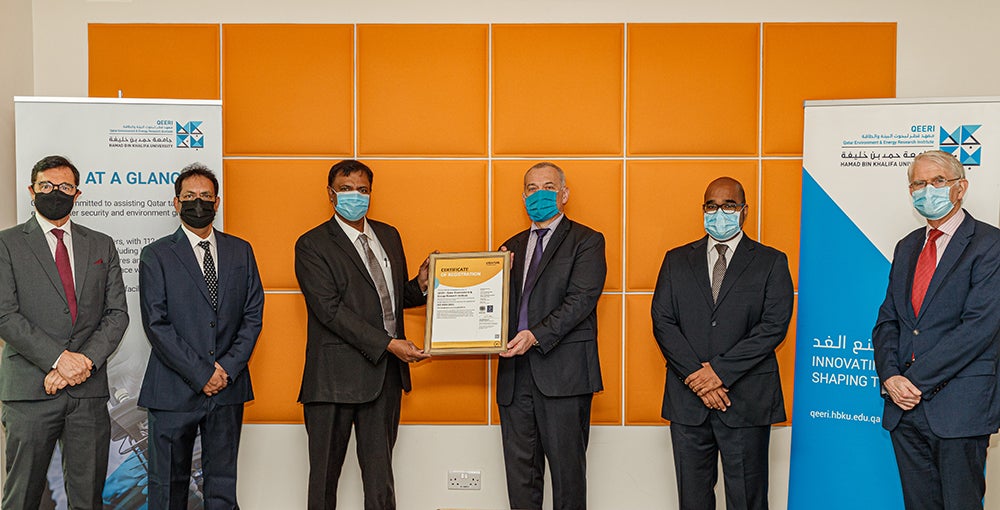
HBKU’s Qatar Environment and Energy Research Institute Awarded ISO Certification for its Integrated Management System
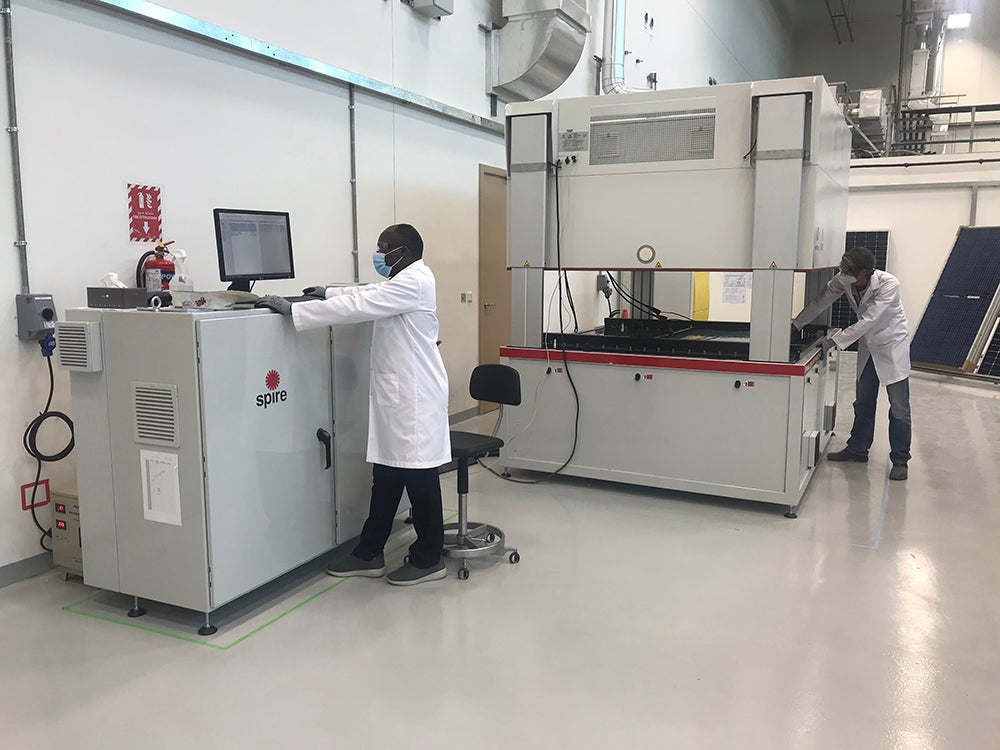
HBKU’s Qatar Environment and Energy Research Institute a Growing Force in Solar Technology Research
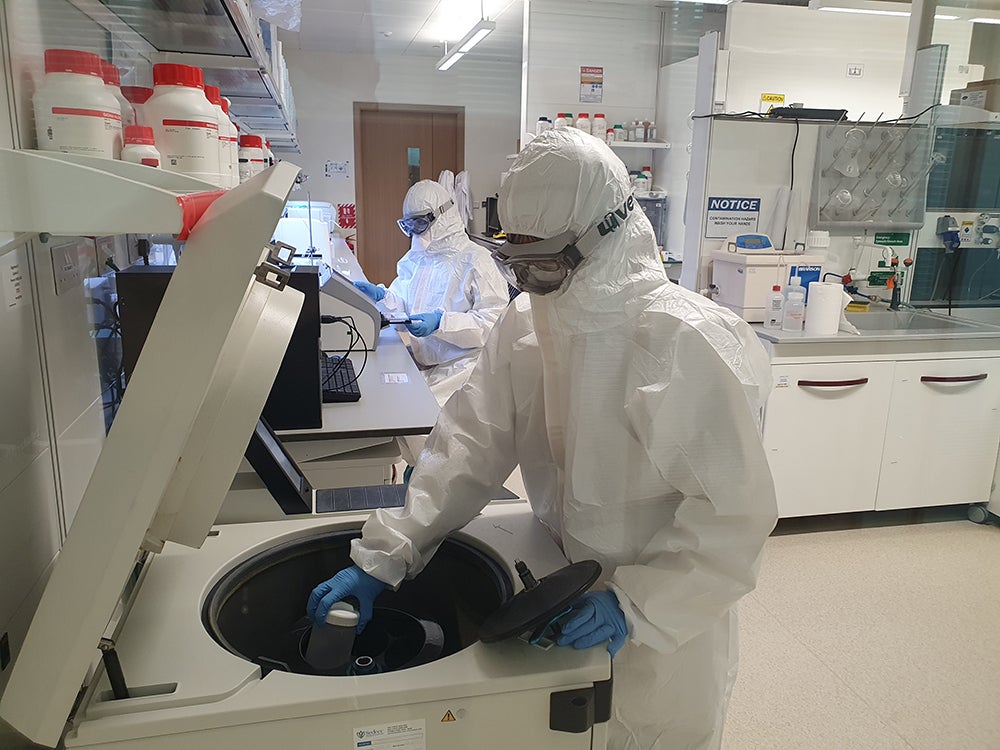
HBKU’s Qatar Environment and Energy Research Institute and Qatar Stakeholders Collaborative Project Aims to Detect COVID-19 in Wastewater
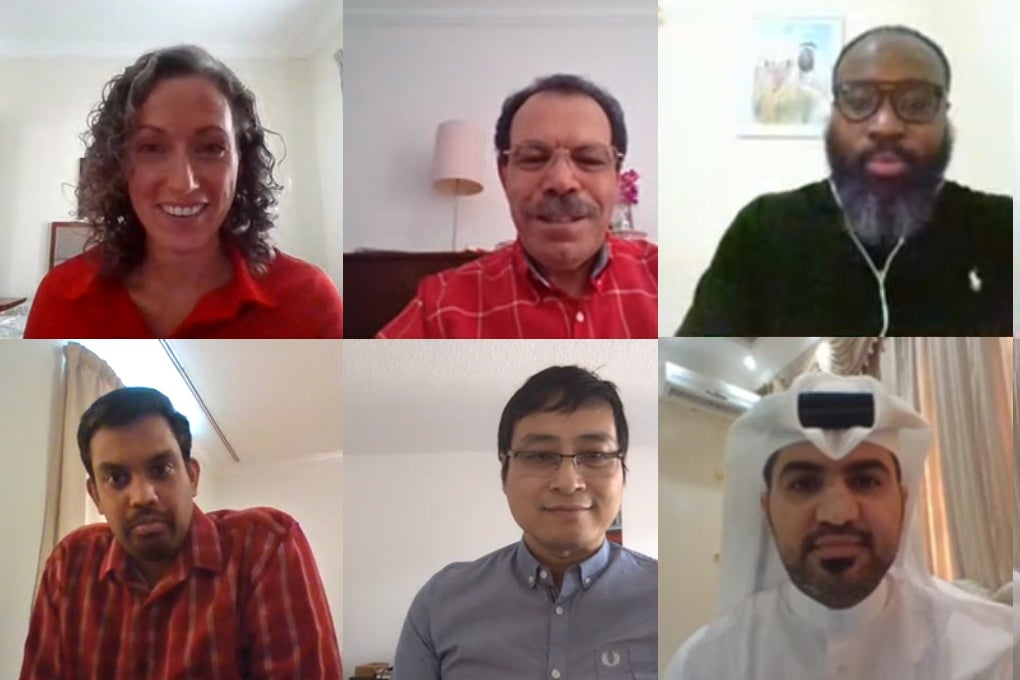
Qatar Environment and Energy Research Institute at HBKU Develops New Technology to Remove Oil from Seawater

QEERI at HBKU to Lead New Project Focused on Reducing Atmospheric Carbon Dioxide

Qatar Environment and Energy Research Institute Providing Key Data for Development of Al Kharsaah 800MWp Photovoltaic Plant

Experts Combine Efforts to Address Climate Challenges at Qatar Environment and Energy Research Institute Conference

Qatar Environment and Energy Research Institute’s Second Science Majlis Promotes Awareness of Managing Scarce Water Resources

Research and Development Efforts by Qatar Environment and Energy Research Institute Focus on Innovation in Carbon Capture, Utilization, and Storage Technologies

Qatar Environment and Energy Research Institute Develops and Installs MED Seawater Desalination Pilot Plant in Dukhan

HBKU’s Qatar Environment and Energy Research Institute Awarded ISO Certification for its Integrated Management System

HBKU’s Qatar Environment and Energy Research Institute a Growing Force in Solar Technology Research

HBKU’s Qatar Environment and Energy Research Institute and Qatar Stakeholders Collaborative Project Aims to Detect COVID-19 in Wastewater

Qatar Environment and Energy Research Institute at HBKU Develops New Technology to Remove Oil from Seawater

QEERI at HBKU to Lead New Project Focused on Reducing Atmospheric Carbon Dioxide

Qatar Environment and Energy Research Institute Providing Key Data for Development of Al Kharsaah 800MWp Photovoltaic Plant

Experts Combine Efforts to Address Climate Challenges at Qatar Environment and Energy Research Institute Conference

Qatar Environment and Energy Research Institute’s Second Science Majlis Promotes Awareness of Managing Scarce Water Resources

Research and Development Efforts by Qatar Environment and Energy Research Institute Focus on Innovation in Carbon Capture, Utilization, and Storage Technologies

Qatar Environment and Energy Research Institute Develops and Installs MED Seawater Desalination Pilot Plant in Dukhan

HBKU’s Qatar Environment and Energy Research Institute Awarded ISO Certification for its Integrated Management System

HBKU’s Qatar Environment and Energy Research Institute a Growing Force in Solar Technology Research

HBKU’s Qatar Environment and Energy Research Institute and Qatar Stakeholders Collaborative Project Aims to Detect COVID-19 in Wastewater

Qatar Environment and Energy Research Institute at HBKU Develops New Technology to Remove Oil from Seawater

QEERI at HBKU to Lead New Project Focused on Reducing Atmospheric Carbon Dioxide

Qatar Environment and Energy Research Institute Providing Key Data for Development of Al Kharsaah 800MWp Photovoltaic Plant

Experts Combine Efforts to Address Climate Challenges at Qatar Environment and Energy Research Institute Conference

Qatar Environment and Energy Research Institute’s Second Science Majlis Promotes Awareness of Managing Scarce Water Resources

Research and Development Efforts by Qatar Environment and Energy Research Institute Focus on Innovation in Carbon Capture, Utilization, and Storage Technologies

Qatar Environment and Energy Research Institute Develops and Installs MED Seawater Desalination Pilot Plant in Dukhan

HBKU’s Qatar Environment and Energy Research Institute Awarded ISO Certification for its Integrated Management System

HBKU’s Qatar Environment and Energy Research Institute a Growing Force in Solar Technology Research

HBKU’s Qatar Environment and Energy Research Institute and Qatar Stakeholders Collaborative Project Aims to Detect COVID-19 in Wastewater

Qatar Environment and Energy Research Institute at HBKU Develops New Technology to Remove Oil from Seawater

QEERI at HBKU to Lead New Project Focused on Reducing Atmospheric Carbon Dioxide

Qatar Environment and Energy Research Institute Providing Key Data for Development of Al Kharsaah 800MWp Photovoltaic Plant

Experts Combine Efforts to Address Climate Challenges at Qatar Environment and Energy Research Institute Conference

Qatar Environment and Energy Research Institute’s Second Science Majlis Promotes Awareness of Managing Scarce Water Resources

Research and Development Efforts by Qatar Environment and Energy Research Institute Focus on Innovation in Carbon Capture, Utilization, and Storage Technologies

Qatar Environment and Energy Research Institute Develops and Installs MED Seawater Desalination Pilot Plant in Dukhan

HBKU’s Qatar Environment and Energy Research Institute Awarded ISO Certification for its Integrated Management System

HBKU’s Qatar Environment and Energy Research Institute a Growing Force in Solar Technology Research

HBKU’s Qatar Environment and Energy Research Institute and Qatar Stakeholders Collaborative Project Aims to Detect COVID-19 in Wastewater

Qatar Environment and Energy Research Institute at HBKU Develops New Technology to Remove Oil from Seawater

QEERI at HBKU to Lead New Project Focused on Reducing Atmospheric Carbon Dioxide

Qatar Environment and Energy Research Institute Providing Key Data for Development of Al Kharsaah 800MWp Photovoltaic Plant

Experts Combine Efforts to Address Climate Challenges at Qatar Environment and Energy Research Institute Conference

Qatar Environment and Energy Research Institute’s Second Science Majlis Promotes Awareness of Managing Scarce Water Resources

Research and Development Efforts by Qatar Environment and Energy Research Institute Focus on Innovation in Carbon Capture, Utilization, and Storage Technologies

Qatar Environment and Energy Research Institute Develops and Installs MED Seawater Desalination Pilot Plant in Dukhan

HBKU’s Qatar Environment and Energy Research Institute Awarded ISO Certification for its Integrated Management System

HBKU’s Qatar Environment and Energy Research Institute a Growing Force in Solar Technology Research

HBKU’s Qatar Environment and Energy Research Institute and Qatar Stakeholders Collaborative Project Aims to Detect COVID-19 in Wastewater

Qatar Environment and Energy Research Institute at HBKU Develops New Technology to Remove Oil from Seawater

QEERI at HBKU to Lead New Project Focused on Reducing Atmospheric Carbon Dioxide

Qatar Environment and Energy Research Institute Providing Key Data for Development of Al Kharsaah 800MWp Photovoltaic Plant

Experts Combine Efforts to Address Climate Challenges at Qatar Environment and Energy Research Institute Conference

Qatar Environment and Energy Research Institute’s Second Science Majlis Promotes Awareness of Managing Scarce Water Resources

Research and Development Efforts by Qatar Environment and Energy Research Institute Focus on Innovation in Carbon Capture, Utilization, and Storage Technologies

Qatar Environment and Energy Research Institute Develops and Installs MED Seawater Desalination Pilot Plant in Dukhan

HBKU’s Qatar Environment and Energy Research Institute Awarded ISO Certification for its Integrated Management System

HBKU’s Qatar Environment and Energy Research Institute a Growing Force in Solar Technology Research

HBKU’s Qatar Environment and Energy Research Institute and Qatar Stakeholders Collaborative Project Aims to Detect COVID-19 in Wastewater

Qatar Environment and Energy Research Institute at HBKU Develops New Technology to Remove Oil from Seawater

QEERI at HBKU to Lead New Project Focused on Reducing Atmospheric Carbon Dioxide

Qatar Environment and Energy Research Institute Providing Key Data for Development of Al Kharsaah 800MWp Photovoltaic Plant

Experts Combine Efforts to Address Climate Challenges at Qatar Environment and Energy Research Institute Conference

Qatar Environment and Energy Research Institute’s Second Science Majlis Promotes Awareness of Managing Scarce Water Resources

Research and Development Efforts by Qatar Environment and Energy Research Institute Focus on Innovation in Carbon Capture, Utilization, and Storage Technologies

Qatar Environment and Energy Research Institute Develops and Installs MED Seawater Desalination Pilot Plant in Dukhan

HBKU’s Qatar Environment and Energy Research Institute Awarded ISO Certification for its Integrated Management System

HBKU’s Qatar Environment and Energy Research Institute a Growing Force in Solar Technology Research

HBKU’s Qatar Environment and Energy Research Institute and Qatar Stakeholders Collaborative Project Aims to Detect COVID-19 in Wastewater

Qatar Environment and Energy Research Institute at HBKU Develops New Technology to Remove Oil from Seawater

QEERI at HBKU to Lead New Project Focused on Reducing Atmospheric Carbon Dioxide

Qatar Environment and Energy Research Institute Providing Key Data for Development of Al Kharsaah 800MWp Photovoltaic Plant

Experts Combine Efforts to Address Climate Challenges at Qatar Environment and Energy Research Institute Conference

Qatar Environment and Energy Research Institute’s Second Science Majlis Promotes Awareness of Managing Scarce Water Resources

Research and Development Efforts by Qatar Environment and Energy Research Institute Focus on Innovation in Carbon Capture, Utilization, and Storage Technologies

Qatar Environment and Energy Research Institute Develops and Installs MED Seawater Desalination Pilot Plant in Dukhan

HBKU’s Qatar Environment and Energy Research Institute Awarded ISO Certification for its Integrated Management System

HBKU’s Qatar Environment and Energy Research Institute a Growing Force in Solar Technology Research

HBKU’s Qatar Environment and Energy Research Institute and Qatar Stakeholders Collaborative Project Aims to Detect COVID-19 in Wastewater

Qatar Environment and Energy Research Institute at HBKU Develops New Technology to Remove Oil from Seawater

QEERI at HBKU to Lead New Project Focused on Reducing Atmospheric Carbon Dioxide

Qatar Environment and Energy Research Institute Providing Key Data for Development of Al Kharsaah 800MWp Photovoltaic Plant

Experts Combine Efforts to Address Climate Challenges at Qatar Environment and Energy Research Institute Conference

Qatar Environment and Energy Research Institute’s Second Science Majlis Promotes Awareness of Managing Scarce Water Resources

Research and Development Efforts by Qatar Environment and Energy Research Institute Focus on Innovation in Carbon Capture, Utilization, and Storage Technologies

Qatar Environment and Energy Research Institute Develops and Installs MED Seawater Desalination Pilot Plant in Dukhan

HBKU’s Qatar Environment and Energy Research Institute Awarded ISO Certification for its Integrated Management System

HBKU’s Qatar Environment and Energy Research Institute a Growing Force in Solar Technology Research

HBKU’s Qatar Environment and Energy Research Institute and Qatar Stakeholders Collaborative Project Aims to Detect COVID-19 in Wastewater

Qatar Environment and Energy Research Institute at HBKU Develops New Technology to Remove Oil from Seawater

QEERI at HBKU to Lead New Project Focused on Reducing Atmospheric Carbon Dioxide

Qatar Environment and Energy Research Institute Providing Key Data for Development of Al Kharsaah 800MWp Photovoltaic Plant

Experts Combine Efforts to Address Climate Challenges at Qatar Environment and Energy Research Institute Conference

Qatar Environment and Energy Research Institute’s Second Science Majlis Promotes Awareness of Managing Scarce Water Resources

Research and Development Efforts by Qatar Environment and Energy Research Institute Focus on Innovation in Carbon Capture, Utilization, and Storage Technologies

Qatar Environment and Energy Research Institute Develops and Installs MED Seawater Desalination Pilot Plant in Dukhan

HBKU’s Qatar Environment and Energy Research Institute Awarded ISO Certification for its Integrated Management System

HBKU’s Qatar Environment and Energy Research Institute a Growing Force in Solar Technology Research

HBKU’s Qatar Environment and Energy Research Institute and Qatar Stakeholders Collaborative Project Aims to Detect COVID-19 in Wastewater

Qatar Environment and Energy Research Institute at HBKU Develops New Technology to Remove Oil from Seawater

QEERI at HBKU to Lead New Project Focused on Reducing Atmospheric Carbon Dioxide

Qatar Environment and Energy Research Institute Providing Key Data for Development of Al Kharsaah 800MWp Photovoltaic Plant

Experts Combine Efforts to Address Climate Challenges at Qatar Environment and Energy Research Institute Conference

Qatar Environment and Energy Research Institute’s Second Science Majlis Promotes Awareness of Managing Scarce Water Resources

Research and Development Efforts by Qatar Environment and Energy Research Institute Focus on Innovation in Carbon Capture, Utilization, and Storage Technologies

Qatar Environment and Energy Research Institute Develops and Installs MED Seawater Desalination Pilot Plant in Dukhan

HBKU’s Qatar Environment and Energy Research Institute Awarded ISO Certification for its Integrated Management System

HBKU’s Qatar Environment and Energy Research Institute a Growing Force in Solar Technology Research

HBKU’s Qatar Environment and Energy Research Institute and Qatar Stakeholders Collaborative Project Aims to Detect COVID-19 in Wastewater

Qatar Environment and Energy Research Institute at HBKU Develops New Technology to Remove Oil from Seawater

QEERI at HBKU to Lead New Project Focused on Reducing Atmospheric Carbon Dioxide

Qatar Environment and Energy Research Institute Providing Key Data for Development of Al Kharsaah 800MWp Photovoltaic Plant

Experts Combine Efforts to Address Climate Challenges at Qatar Environment and Energy Research Institute Conference

Qatar Environment and Energy Research Institute’s Second Science Majlis Promotes Awareness of Managing Scarce Water Resources

Research and Development Efforts by Qatar Environment and Energy Research Institute Focus on Innovation in Carbon Capture, Utilization, and Storage Technologies

Qatar Environment and Energy Research Institute Develops and Installs MED Seawater Desalination Pilot Plant in Dukhan

HBKU’s Qatar Environment and Energy Research Institute Awarded ISO Certification for its Integrated Management System

HBKU’s Qatar Environment and Energy Research Institute a Growing Force in Solar Technology Research

HBKU’s Qatar Environment and Energy Research Institute and Qatar Stakeholders Collaborative Project Aims to Detect COVID-19 in Wastewater

Qatar Environment and Energy Research Institute at HBKU Develops New Technology to Remove Oil from Seawater

QEERI at HBKU to Lead New Project Focused on Reducing Atmospheric Carbon Dioxide

Qatar Environment and Energy Research Institute Providing Key Data for Development of Al Kharsaah 800MWp Photovoltaic Plant

Experts Combine Efforts to Address Climate Challenges at Qatar Environment and Energy Research Institute Conference

Qatar Environment and Energy Research Institute’s Second Science Majlis Promotes Awareness of Managing Scarce Water Resources

Research and Development Efforts by Qatar Environment and Energy Research Institute Focus on Innovation in Carbon Capture, Utilization, and Storage Technologies

Qatar Environment and Energy Research Institute Develops and Installs MED Seawater Desalination Pilot Plant in Dukhan

HBKU’s Qatar Environment and Energy Research Institute Awarded ISO Certification for its Integrated Management System

HBKU’s Qatar Environment and Energy Research Institute a Growing Force in Solar Technology Research

HBKU’s Qatar Environment and Energy Research Institute and Qatar Stakeholders Collaborative Project Aims to Detect COVID-19 in Wastewater

Qatar Environment and Energy Research Institute at HBKU Develops New Technology to Remove Oil from Seawater

QEERI at HBKU to Lead New Project Focused on Reducing Atmospheric Carbon Dioxide

Qatar Environment and Energy Research Institute Providing Key Data for Development of Al Kharsaah 800MWp Photovoltaic Plant

Experts Combine Efforts to Address Climate Challenges at Qatar Environment and Energy Research Institute Conference

Qatar Environment and Energy Research Institute’s Second Science Majlis Promotes Awareness of Managing Scarce Water Resources

Research and Development Efforts by Qatar Environment and Energy Research Institute Focus on Innovation in Carbon Capture, Utilization, and Storage Technologies

Qatar Environment and Energy Research Institute Develops and Installs MED Seawater Desalination Pilot Plant in Dukhan

HBKU’s Qatar Environment and Energy Research Institute Awarded ISO Certification for its Integrated Management System

HBKU’s Qatar Environment and Energy Research Institute a Growing Force in Solar Technology Research

HBKU’s Qatar Environment and Energy Research Institute and Qatar Stakeholders Collaborative Project Aims to Detect COVID-19 in Wastewater

Qatar Environment and Energy Research Institute at HBKU Develops New Technology to Remove Oil from Seawater

QEERI at HBKU to Lead New Project Focused on Reducing Atmospheric Carbon Dioxide

Qatar Environment and Energy Research Institute Providing Key Data for Development of Al Kharsaah 800MWp Photovoltaic Plant

Experts Combine Efforts to Address Climate Challenges at Qatar Environment and Energy Research Institute Conference

Qatar Environment and Energy Research Institute’s Second Science Majlis Promotes Awareness of Managing Scarce Water Resources

Research and Development Efforts by Qatar Environment and Energy Research Institute Focus on Innovation in Carbon Capture, Utilization, and Storage Technologies

Qatar Environment and Energy Research Institute Develops and Installs MED Seawater Desalination Pilot Plant in Dukhan

HBKU’s Qatar Environment and Energy Research Institute Awarded ISO Certification for its Integrated Management System

HBKU’s Qatar Environment and Energy Research Institute a Growing Force in Solar Technology Research

HBKU’s Qatar Environment and Energy Research Institute and Qatar Stakeholders Collaborative Project Aims to Detect COVID-19 in Wastewater

Qatar Environment and Energy Research Institute at HBKU Develops New Technology to Remove Oil from Seawater

QEERI at HBKU to Lead New Project Focused on Reducing Atmospheric Carbon Dioxide

Qatar Environment and Energy Research Institute Providing Key Data for Development of Al Kharsaah 800MWp Photovoltaic Plant

Experts Combine Efforts to Address Climate Challenges at Qatar Environment and Energy Research Institute Conference

Qatar Environment and Energy Research Institute’s Second Science Majlis Promotes Awareness of Managing Scarce Water Resources

Research and Development Efforts by Qatar Environment and Energy Research Institute Focus on Innovation in Carbon Capture, Utilization, and Storage Technologies

Qatar Environment and Energy Research Institute Develops and Installs MED Seawater Desalination Pilot Plant in Dukhan

HBKU’s Qatar Environment and Energy Research Institute Awarded ISO Certification for its Integrated Management System

HBKU’s Qatar Environment and Energy Research Institute a Growing Force in Solar Technology Research

HBKU’s Qatar Environment and Energy Research Institute and Qatar Stakeholders Collaborative Project Aims to Detect COVID-19 in Wastewater

Qatar Environment and Energy Research Institute at HBKU Develops New Technology to Remove Oil from Seawater

QEERI at HBKU to Lead New Project Focused on Reducing Atmospheric Carbon Dioxide

Qatar Environment and Energy Research Institute Providing Key Data for Development of Al Kharsaah 800MWp Photovoltaic Plant

Experts Combine Efforts to Address Climate Challenges at Qatar Environment and Energy Research Institute Conference

Qatar Environment and Energy Research Institute’s Second Science Majlis Promotes Awareness of Managing Scarce Water Resources

Research and Development Efforts by Qatar Environment and Energy Research Institute Focus on Innovation in Carbon Capture, Utilization, and Storage Technologies

Qatar Environment and Energy Research Institute Develops and Installs MED Seawater Desalination Pilot Plant in Dukhan

HBKU’s Qatar Environment and Energy Research Institute Awarded ISO Certification for its Integrated Management System

HBKU’s Qatar Environment and Energy Research Institute a Growing Force in Solar Technology Research

HBKU’s Qatar Environment and Energy Research Institute and Qatar Stakeholders Collaborative Project Aims to Detect COVID-19 in Wastewater

Qatar Environment and Energy Research Institute at HBKU Develops New Technology to Remove Oil from Seawater

QEERI at HBKU to Lead New Project Focused on Reducing Atmospheric Carbon Dioxide

Qatar Environment and Energy Research Institute Providing Key Data for Development of Al Kharsaah 800MWp Photovoltaic Plant

Experts Combine Efforts to Address Climate Challenges at Qatar Environment and Energy Research Institute Conference

Qatar Environment and Energy Research Institute’s Second Science Majlis Promotes Awareness of Managing Scarce Water Resources

Research and Development Efforts by Qatar Environment and Energy Research Institute Focus on Innovation in Carbon Capture, Utilization, and Storage Technologies

Qatar Environment and Energy Research Institute Develops and Installs MED Seawater Desalination Pilot Plant in Dukhan

HBKU’s Qatar Environment and Energy Research Institute Awarded ISO Certification for its Integrated Management System

HBKU’s Qatar Environment and Energy Research Institute a Growing Force in Solar Technology Research

HBKU’s Qatar Environment and Energy Research Institute and Qatar Stakeholders Collaborative Project Aims to Detect COVID-19 in Wastewater

Qatar Environment and Energy Research Institute at HBKU Develops New Technology to Remove Oil from Seawater

QEERI at HBKU to Lead New Project Focused on Reducing Atmospheric Carbon Dioxide

Qatar Environment and Energy Research Institute Providing Key Data for Development of Al Kharsaah 800MWp Photovoltaic Plant

Experts Combine Efforts to Address Climate Challenges at Qatar Environment and Energy Research Institute Conference

Qatar Environment and Energy Research Institute’s Second Science Majlis Promotes Awareness of Managing Scarce Water Resources

Research and Development Efforts by Qatar Environment and Energy Research Institute Focus on Innovation in Carbon Capture, Utilization, and Storage Technologies

Qatar Environment and Energy Research Institute Develops and Installs MED Seawater Desalination Pilot Plant in Dukhan

HBKU’s Qatar Environment and Energy Research Institute Awarded ISO Certification for its Integrated Management System

HBKU’s Qatar Environment and Energy Research Institute a Growing Force in Solar Technology Research

HBKU’s Qatar Environment and Energy Research Institute and Qatar Stakeholders Collaborative Project Aims to Detect COVID-19 in Wastewater

Qatar Environment and Energy Research Institute at HBKU Develops New Technology to Remove Oil from Seawater

QEERI at HBKU to Lead New Project Focused on Reducing Atmospheric Carbon Dioxide

Qatar Environment and Energy Research Institute Providing Key Data for Development of Al Kharsaah 800MWp Photovoltaic Plant

Experts Combine Efforts to Address Climate Challenges at Qatar Environment and Energy Research Institute Conference

Qatar Environment and Energy Research Institute’s Second Science Majlis Promotes Awareness of Managing Scarce Water Resources

Research and Development Efforts by Qatar Environment and Energy Research Institute Focus on Innovation in Carbon Capture, Utilization, and Storage Technologies

Qatar Environment and Energy Research Institute Develops and Installs MED Seawater Desalination Pilot Plant in Dukhan

HBKU’s Qatar Environment and Energy Research Institute Awarded ISO Certification for its Integrated Management System

HBKU’s Qatar Environment and Energy Research Institute a Growing Force in Solar Technology Research

HBKU’s Qatar Environment and Energy Research Institute and Qatar Stakeholders Collaborative Project Aims to Detect COVID-19 in Wastewater

Qatar Environment and Energy Research Institute at HBKU Develops New Technology to Remove Oil from Seawater

QEERI at HBKU to Lead New Project Focused on Reducing Atmospheric Carbon Dioxide

Qatar Environment and Energy Research Institute Providing Key Data for Development of Al Kharsaah 800MWp Photovoltaic Plant

Experts Combine Efforts to Address Climate Challenges at Qatar Environment and Energy Research Institute Conference

Qatar Environment and Energy Research Institute’s Second Science Majlis Promotes Awareness of Managing Scarce Water Resources

Research and Development Efforts by Qatar Environment and Energy Research Institute Focus on Innovation in Carbon Capture, Utilization, and Storage Technologies

Qatar Environment and Energy Research Institute Develops and Installs MED Seawater Desalination Pilot Plant in Dukhan

HBKU’s Qatar Environment and Energy Research Institute Awarded ISO Certification for its Integrated Management System

HBKU’s Qatar Environment and Energy Research Institute a Growing Force in Solar Technology Research

HBKU’s Qatar Environment and Energy Research Institute and Qatar Stakeholders Collaborative Project Aims to Detect COVID-19 in Wastewater

Qatar Environment and Energy Research Institute at HBKU Develops New Technology to Remove Oil from Seawater

QEERI at HBKU to Lead New Project Focused on Reducing Atmospheric Carbon Dioxide

Qatar Environment and Energy Research Institute Providing Key Data for Development of Al Kharsaah 800MWp Photovoltaic Plant

Experts Combine Efforts to Address Climate Challenges at Qatar Environment and Energy Research Institute Conference

Qatar Environment and Energy Research Institute’s Second Science Majlis Promotes Awareness of Managing Scarce Water Resources

Research and Development Efforts by Qatar Environment and Energy Research Institute Focus on Innovation in Carbon Capture, Utilization, and Storage Technologies

Qatar Environment and Energy Research Institute Develops and Installs MED Seawater Desalination Pilot Plant in Dukhan

HBKU’s Qatar Environment and Energy Research Institute Awarded ISO Certification for its Integrated Management System

HBKU’s Qatar Environment and Energy Research Institute a Growing Force in Solar Technology Research

HBKU’s Qatar Environment and Energy Research Institute and Qatar Stakeholders Collaborative Project Aims to Detect COVID-19 in Wastewater

Qatar Environment and Energy Research Institute at HBKU Develops New Technology to Remove Oil from Seawater

QEERI at HBKU to Lead New Project Focused on Reducing Atmospheric Carbon Dioxide

Qatar Environment and Energy Research Institute Providing Key Data for Development of Al Kharsaah 800MWp Photovoltaic Plant

Experts Combine Efforts to Address Climate Challenges at Qatar Environment and Energy Research Institute Conference

Qatar Environment and Energy Research Institute’s Second Science Majlis Promotes Awareness of Managing Scarce Water Resources

Research and Development Efforts by Qatar Environment and Energy Research Institute Focus on Innovation in Carbon Capture, Utilization, and Storage Technologies

Qatar Environment and Energy Research Institute Develops and Installs MED Seawater Desalination Pilot Plant in Dukhan

HBKU’s Qatar Environment and Energy Research Institute Awarded ISO Certification for its Integrated Management System

HBKU’s Qatar Environment and Energy Research Institute a Growing Force in Solar Technology Research

HBKU’s Qatar Environment and Energy Research Institute and Qatar Stakeholders Collaborative Project Aims to Detect COVID-19 in Wastewater

Qatar Environment and Energy Research Institute at HBKU Develops New Technology to Remove Oil from Seawater

QEERI at HBKU to Lead New Project Focused on Reducing Atmospheric Carbon Dioxide

Qatar Environment and Energy Research Institute Providing Key Data for Development of Al Kharsaah 800MWp Photovoltaic Plant

Experts Combine Efforts to Address Climate Challenges at Qatar Environment and Energy Research Institute Conference

Qatar Environment and Energy Research Institute’s Second Science Majlis Promotes Awareness of Managing Scarce Water Resources

Research and Development Efforts by Qatar Environment and Energy Research Institute Focus on Innovation in Carbon Capture, Utilization, and Storage Technologies

Qatar Environment and Energy Research Institute Develops and Installs MED Seawater Desalination Pilot Plant in Dukhan

HBKU’s Qatar Environment and Energy Research Institute Awarded ISO Certification for its Integrated Management System

HBKU’s Qatar Environment and Energy Research Institute a Growing Force in Solar Technology Research

HBKU’s Qatar Environment and Energy Research Institute and Qatar Stakeholders Collaborative Project Aims to Detect COVID-19 in Wastewater

Qatar Environment and Energy Research Institute at HBKU Develops New Technology to Remove Oil from Seawater

QEERI at HBKU to Lead New Project Focused on Reducing Atmospheric Carbon Dioxide

Qatar Environment and Energy Research Institute Providing Key Data for Development of Al Kharsaah 800MWp Photovoltaic Plant

Experts Combine Efforts to Address Climate Challenges at Qatar Environment and Energy Research Institute Conference

Qatar Environment and Energy Research Institute’s Second Science Majlis Promotes Awareness of Managing Scarce Water Resources

Research and Development Efforts by Qatar Environment and Energy Research Institute Focus on Innovation in Carbon Capture, Utilization, and Storage Technologies

Qatar Environment and Energy Research Institute Develops and Installs MED Seawater Desalination Pilot Plant in Dukhan

HBKU’s Qatar Environment and Energy Research Institute Awarded ISO Certification for its Integrated Management System

HBKU’s Qatar Environment and Energy Research Institute a Growing Force in Solar Technology Research

HBKU’s Qatar Environment and Energy Research Institute and Qatar Stakeholders Collaborative Project Aims to Detect COVID-19 in Wastewater

Qatar Environment and Energy Research Institute at HBKU Develops New Technology to Remove Oil from Seawater

QEERI at HBKU to Lead New Project Focused on Reducing Atmospheric Carbon Dioxide

Qatar Environment and Energy Research Institute Providing Key Data for Development of Al Kharsaah 800MWp Photovoltaic Plant

Experts Combine Efforts to Address Climate Challenges at Qatar Environment and Energy Research Institute Conference

Qatar Environment and Energy Research Institute’s Second Science Majlis Promotes Awareness of Managing Scarce Water Resources

Research and Development Efforts by Qatar Environment and Energy Research Institute Focus on Innovation in Carbon Capture, Utilization, and Storage Technologies

Qatar Environment and Energy Research Institute Develops and Installs MED Seawater Desalination Pilot Plant in Dukhan

HBKU’s Qatar Environment and Energy Research Institute Awarded ISO Certification for its Integrated Management System

HBKU’s Qatar Environment and Energy Research Institute a Growing Force in Solar Technology Research

HBKU’s Qatar Environment and Energy Research Institute and Qatar Stakeholders Collaborative Project Aims to Detect COVID-19 in Wastewater

Qatar Environment and Energy Research Institute at HBKU Develops New Technology to Remove Oil from Seawater

QEERI at HBKU to Lead New Project Focused on Reducing Atmospheric Carbon Dioxide

Qatar Environment and Energy Research Institute Providing Key Data for Development of Al Kharsaah 800MWp Photovoltaic Plant

Experts Combine Efforts to Address Climate Challenges at Qatar Environment and Energy Research Institute Conference

Qatar Environment and Energy Research Institute’s Second Science Majlis Promotes Awareness of Managing Scarce Water Resources

Research and Development Efforts by Qatar Environment and Energy Research Institute Focus on Innovation in Carbon Capture, Utilization, and Storage Technologies

Qatar Environment and Energy Research Institute Develops and Installs MED Seawater Desalination Pilot Plant in Dukhan

HBKU’s Qatar Environment and Energy Research Institute Awarded ISO Certification for its Integrated Management System

HBKU’s Qatar Environment and Energy Research Institute a Growing Force in Solar Technology Research

HBKU’s Qatar Environment and Energy Research Institute and Qatar Stakeholders Collaborative Project Aims to Detect COVID-19 in Wastewater

Qatar Environment and Energy Research Institute at HBKU Develops New Technology to Remove Oil from Seawater

QEERI at HBKU to Lead New Project Focused on Reducing Atmospheric Carbon Dioxide

Qatar Environment and Energy Research Institute Providing Key Data for Development of Al Kharsaah 800MWp Photovoltaic Plant

Experts Combine Efforts to Address Climate Challenges at Qatar Environment and Energy Research Institute Conference

Qatar Environment and Energy Research Institute’s Second Science Majlis Promotes Awareness of Managing Scarce Water Resources

Research and Development Efforts by Qatar Environment and Energy Research Institute Focus on Innovation in Carbon Capture, Utilization, and Storage Technologies

Qatar Environment and Energy Research Institute Develops and Installs MED Seawater Desalination Pilot Plant in Dukhan

HBKU’s Qatar Environment and Energy Research Institute Awarded ISO Certification for its Integrated Management System

HBKU’s Qatar Environment and Energy Research Institute a Growing Force in Solar Technology Research

HBKU’s Qatar Environment and Energy Research Institute and Qatar Stakeholders Collaborative Project Aims to Detect COVID-19 in Wastewater

Qatar Environment and Energy Research Institute at HBKU Develops New Technology to Remove Oil from Seawater

QEERI at HBKU to Lead New Project Focused on Reducing Atmospheric Carbon Dioxide

Qatar Environment and Energy Research Institute Providing Key Data for Development of Al Kharsaah 800MWp Photovoltaic Plant

Experts Combine Efforts to Address Climate Challenges at Qatar Environment and Energy Research Institute Conference

Qatar Environment and Energy Research Institute’s Second Science Majlis Promotes Awareness of Managing Scarce Water Resources

Research and Development Efforts by Qatar Environment and Energy Research Institute Focus on Innovation in Carbon Capture, Utilization, and Storage Technologies

Qatar Environment and Energy Research Institute Develops and Installs MED Seawater Desalination Pilot Plant in Dukhan

HBKU’s Qatar Environment and Energy Research Institute Awarded ISO Certification for its Integrated Management System

HBKU’s Qatar Environment and Energy Research Institute a Growing Force in Solar Technology Research

HBKU’s Qatar Environment and Energy Research Institute and Qatar Stakeholders Collaborative Project Aims to Detect COVID-19 in Wastewater

Qatar Environment and Energy Research Institute at HBKU Develops New Technology to Remove Oil from Seawater

QEERI at HBKU to Lead New Project Focused on Reducing Atmospheric Carbon Dioxide

Qatar Environment and Energy Research Institute Providing Key Data for Development of Al Kharsaah 800MWp Photovoltaic Plant

Experts Combine Efforts to Address Climate Challenges at Qatar Environment and Energy Research Institute Conference

Qatar Environment and Energy Research Institute’s Second Science Majlis Promotes Awareness of Managing Scarce Water Resources

Research and Development Efforts by Qatar Environment and Energy Research Institute Focus on Innovation in Carbon Capture, Utilization, and Storage Technologies

Qatar Environment and Energy Research Institute Develops and Installs MED Seawater Desalination Pilot Plant in Dukhan

HBKU’s Qatar Environment and Energy Research Institute Awarded ISO Certification for its Integrated Management System

HBKU’s Qatar Environment and Energy Research Institute a Growing Force in Solar Technology Research

HBKU’s Qatar Environment and Energy Research Institute and Qatar Stakeholders Collaborative Project Aims to Detect COVID-19 in Wastewater

Qatar Environment and Energy Research Institute at HBKU Develops New Technology to Remove Oil from Seawater

QEERI at HBKU to Lead New Project Focused on Reducing Atmospheric Carbon Dioxide

Qatar Environment and Energy Research Institute Providing Key Data for Development of Al Kharsaah 800MWp Photovoltaic Plant

Experts Combine Efforts to Address Climate Challenges at Qatar Environment and Energy Research Institute Conference

Qatar Environment and Energy Research Institute’s Second Science Majlis Promotes Awareness of Managing Scarce Water Resources

Research and Development Efforts by Qatar Environment and Energy Research Institute Focus on Innovation in Carbon Capture, Utilization, and Storage Technologies

Qatar Environment and Energy Research Institute Develops and Installs MED Seawater Desalination Pilot Plant in Dukhan

HBKU’s Qatar Environment and Energy Research Institute Awarded ISO Certification for its Integrated Management System

HBKU’s Qatar Environment and Energy Research Institute a Growing Force in Solar Technology Research

HBKU’s Qatar Environment and Energy Research Institute and Qatar Stakeholders Collaborative Project Aims to Detect COVID-19 in Wastewater

Qatar Environment and Energy Research Institute at HBKU Develops New Technology to Remove Oil from Seawater

QEERI at HBKU to Lead New Project Focused on Reducing Atmospheric Carbon Dioxide

Qatar Environment and Energy Research Institute Providing Key Data for Development of Al Kharsaah 800MWp Photovoltaic Plant

Experts Combine Efforts to Address Climate Challenges at Qatar Environment and Energy Research Institute Conference

Qatar Environment and Energy Research Institute’s Second Science Majlis Promotes Awareness of Managing Scarce Water Resources

Research and Development Efforts by Qatar Environment and Energy Research Institute Focus on Innovation in Carbon Capture, Utilization, and Storage Technologies

Qatar Environment and Energy Research Institute Develops and Installs MED Seawater Desalination Pilot Plant in Dukhan

HBKU’s Qatar Environment and Energy Research Institute Awarded ISO Certification for its Integrated Management System

HBKU’s Qatar Environment and Energy Research Institute a Growing Force in Solar Technology Research

HBKU’s Qatar Environment and Energy Research Institute and Qatar Stakeholders Collaborative Project Aims to Detect COVID-19 in Wastewater

Qatar Environment and Energy Research Institute at HBKU Develops New Technology to Remove Oil from Seawater

QEERI at HBKU to Lead New Project Focused on Reducing Atmospheric Carbon Dioxide

Qatar Environment and Energy Research Institute Providing Key Data for Development of Al Kharsaah 800MWp Photovoltaic Plant

Experts Combine Efforts to Address Climate Challenges at Qatar Environment and Energy Research Institute Conference

Qatar Environment and Energy Research Institute’s Second Science Majlis Promotes Awareness of Managing Scarce Water Resources

Research and Development Efforts by Qatar Environment and Energy Research Institute Focus on Innovation in Carbon Capture, Utilization, and Storage Technologies

Qatar Environment and Energy Research Institute Develops and Installs MED Seawater Desalination Pilot Plant in Dukhan

HBKU’s Qatar Environment and Energy Research Institute Awarded ISO Certification for its Integrated Management System

HBKU’s Qatar Environment and Energy Research Institute a Growing Force in Solar Technology Research

HBKU’s Qatar Environment and Energy Research Institute and Qatar Stakeholders Collaborative Project Aims to Detect COVID-19 in Wastewater

Qatar Environment and Energy Research Institute at HBKU Develops New Technology to Remove Oil from Seawater

QEERI at HBKU to Lead New Project Focused on Reducing Atmospheric Carbon Dioxide

Qatar Environment and Energy Research Institute Providing Key Data for Development of Al Kharsaah 800MWp Photovoltaic Plant

Experts Combine Efforts to Address Climate Challenges at Qatar Environment and Energy Research Institute Conference

Qatar Environment and Energy Research Institute’s Second Science Majlis Promotes Awareness of Managing Scarce Water Resources

Research and Development Efforts by Qatar Environment and Energy Research Institute Focus on Innovation in Carbon Capture, Utilization, and Storage Technologies

Qatar Environment and Energy Research Institute Develops and Installs MED Seawater Desalination Pilot Plant in Dukhan

HBKU’s Qatar Environment and Energy Research Institute Awarded ISO Certification for its Integrated Management System

HBKU’s Qatar Environment and Energy Research Institute a Growing Force in Solar Technology Research

HBKU’s Qatar Environment and Energy Research Institute and Qatar Stakeholders Collaborative Project Aims to Detect COVID-19 in Wastewater

Qatar Environment and Energy Research Institute at HBKU Develops New Technology to Remove Oil from Seawater

QEERI at HBKU to Lead New Project Focused on Reducing Atmospheric Carbon Dioxide

Qatar Environment and Energy Research Institute Providing Key Data for Development of Al Kharsaah 800MWp Photovoltaic Plant

Experts Combine Efforts to Address Climate Challenges at Qatar Environment and Energy Research Institute Conference

Qatar Environment and Energy Research Institute’s Second Science Majlis Promotes Awareness of Managing Scarce Water Resources

Research and Development Efforts by Qatar Environment and Energy Research Institute Focus on Innovation in Carbon Capture, Utilization, and Storage Technologies

Qatar Environment and Energy Research Institute Develops and Installs MED Seawater Desalination Pilot Plant in Dukhan

HBKU’s Qatar Environment and Energy Research Institute Awarded ISO Certification for its Integrated Management System

HBKU’s Qatar Environment and Energy Research Institute a Growing Force in Solar Technology Research

HBKU’s Qatar Environment and Energy Research Institute and Qatar Stakeholders Collaborative Project Aims to Detect COVID-19 in Wastewater

Qatar Environment and Energy Research Institute at HBKU Develops New Technology to Remove Oil from Seawater

QEERI at HBKU to Lead New Project Focused on Reducing Atmospheric Carbon Dioxide

Qatar Environment and Energy Research Institute Providing Key Data for Development of Al Kharsaah 800MWp Photovoltaic Plant

Experts Combine Efforts to Address Climate Challenges at Qatar Environment and Energy Research Institute Conference

Qatar Environment and Energy Research Institute’s Second Science Majlis Promotes Awareness of Managing Scarce Water Resources

Research and Development Efforts by Qatar Environment and Energy Research Institute Focus on Innovation in Carbon Capture, Utilization, and Storage Technologies

Qatar Environment and Energy Research Institute Develops and Installs MED Seawater Desalination Pilot Plant in Dukhan

HBKU’s Qatar Environment and Energy Research Institute Awarded ISO Certification for its Integrated Management System

HBKU’s Qatar Environment and Energy Research Institute a Growing Force in Solar Technology Research

HBKU’s Qatar Environment and Energy Research Institute and Qatar Stakeholders Collaborative Project Aims to Detect COVID-19 in Wastewater

Qatar Environment and Energy Research Institute at HBKU Develops New Technology to Remove Oil from Seawater

QEERI at HBKU to Lead New Project Focused on Reducing Atmospheric Carbon Dioxide

Qatar Environment and Energy Research Institute Providing Key Data for Development of Al Kharsaah 800MWp Photovoltaic Plant

Experts Combine Efforts to Address Climate Challenges at Qatar Environment and Energy Research Institute Conference

Qatar Environment and Energy Research Institute’s Second Science Majlis Promotes Awareness of Managing Scarce Water Resources

Research and Development Efforts by Qatar Environment and Energy Research Institute Focus on Innovation in Carbon Capture, Utilization, and Storage Technologies

Qatar Environment and Energy Research Institute Develops and Installs MED Seawater Desalination Pilot Plant in Dukhan

HBKU’s Qatar Environment and Energy Research Institute Awarded ISO Certification for its Integrated Management System

HBKU’s Qatar Environment and Energy Research Institute a Growing Force in Solar Technology Research

HBKU’s Qatar Environment and Energy Research Institute and Qatar Stakeholders Collaborative Project Aims to Detect COVID-19 in Wastewater

Qatar Environment and Energy Research Institute at HBKU Develops New Technology to Remove Oil from Seawater

QEERI at HBKU to Lead New Project Focused on Reducing Atmospheric Carbon Dioxide

Qatar Environment and Energy Research Institute Providing Key Data for Development of Al Kharsaah 800MWp Photovoltaic Plant

Experts Combine Efforts to Address Climate Challenges at Qatar Environment and Energy Research Institute Conference

Qatar Environment and Energy Research Institute’s Second Science Majlis Promotes Awareness of Managing Scarce Water Resources

Research and Development Efforts by Qatar Environment and Energy Research Institute Focus on Innovation in Carbon Capture, Utilization, and Storage Technologies

Qatar Environment and Energy Research Institute Develops and Installs MED Seawater Desalination Pilot Plant in Dukhan

HBKU’s Qatar Environment and Energy Research Institute Awarded ISO Certification for its Integrated Management System

HBKU’s Qatar Environment and Energy Research Institute a Growing Force in Solar Technology Research

HBKU’s Qatar Environment and Energy Research Institute and Qatar Stakeholders Collaborative Project Aims to Detect COVID-19 in Wastewater

Qatar Environment and Energy Research Institute at HBKU Develops New Technology to Remove Oil from Seawater

QEERI at HBKU to Lead New Project Focused on Reducing Atmospheric Carbon Dioxide

Qatar Environment and Energy Research Institute Providing Key Data for Development of Al Kharsaah 800MWp Photovoltaic Plant

Experts Combine Efforts to Address Climate Challenges at Qatar Environment and Energy Research Institute Conference

Qatar Environment and Energy Research Institute’s Second Science Majlis Promotes Awareness of Managing Scarce Water Resources

Research and Development Efforts by Qatar Environment and Energy Research Institute Focus on Innovation in Carbon Capture, Utilization, and Storage Technologies

Qatar Environment and Energy Research Institute Develops and Installs MED Seawater Desalination Pilot Plant in Dukhan

HBKU’s Qatar Environment and Energy Research Institute Awarded ISO Certification for its Integrated Management System

HBKU’s Qatar Environment and Energy Research Institute a Growing Force in Solar Technology Research

HBKU’s Qatar Environment and Energy Research Institute and Qatar Stakeholders Collaborative Project Aims to Detect COVID-19 in Wastewater

Qatar Environment and Energy Research Institute at HBKU Develops New Technology to Remove Oil from Seawater

QEERI at HBKU to Lead New Project Focused on Reducing Atmospheric Carbon Dioxide

Qatar Environment and Energy Research Institute Providing Key Data for Development of Al Kharsaah 800MWp Photovoltaic Plant






